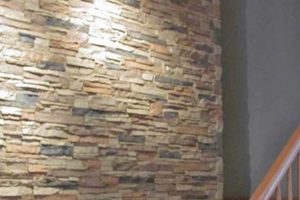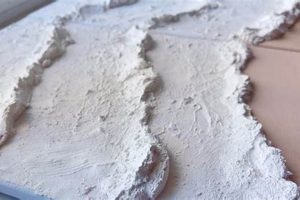Decorative trim applied to walls by homeowners is a popular method to enhance the aesthetic appeal of interior spaces. This process typically involves selecting various styles of molding, cutting them to size, and adhering them to the wall surface to create patterns or frames. These patterns can range from simple wainscoting to complex geometric designs, providing a customizable solution for interior decoration.
The application of decorative trim to walls offers a cost-effective alternative to extensive renovations, providing significant visual impact. It introduces texture, depth, and architectural interest to otherwise plain surfaces. Historically, such enhancements were employed to protect walls from damage and to insulate rooms; however, modern applications primarily focus on aesthetics and personalization, allowing individuals to express their style and elevate their living spaces.
The subsequent sections will delve into the selection of appropriate materials, provide step-by-step guidance on the installation process, and offer practical advice on achieving professional-looking results. Careful planning and execution are key to a successful outcome, transforming a room with relative ease and minimal expense.
Essential Guidance for Wall Trim Application
Achieving a professional finish when applying decorative trim to walls requires meticulous planning and execution. The following guidelines provide valuable insights to ensure a successful and visually appealing outcome.
Tip 1: Precise Measurement is Paramount: Prior to any cutting, accurately measure the wall space and calculate the required lengths of trim. Double-check these measurements to mitigate errors and minimize material waste.
Tip 2: Material Selection Affects the Final Result: Choose a trim material that complements the existing decor and is appropriate for the intended style. Consider factors such as moisture resistance and paintability when making this selection. MDF is suitable for paint-grade applications while solid wood is ideal for stain grade applications.
Tip 3: Adhere to Miter Cutting Standards: When creating corners, employ accurate miter cuts at a 45-degree angle. A miter saw is essential for achieving clean, precise cuts. Improper mitering leads to gaps and detracts from the finished appearance.
Tip 4: Secure Attachment is Critical: Use construction adhesive and finish nails to firmly affix the trim to the wall. Ensure that nails are countersunk and that any gaps are filled with wood filler before painting.
Tip 5: Surface Preparation Enhances Adhesion: Clean and prime the wall surface before applying adhesive. This step promotes better adhesion and a more durable bond between the trim and the wall.
Tip 6: Caulk for a Seamless Finish: Apply a bead of paintable caulk along all edges of the trim to conceal gaps and create a seamless transition between the trim and the wall. Smooth the caulk with a wet finger or a caulk smoothing tool for a professional appearance.
Tip 7: Proper Painting Techniques Yield Professional Results: Apply multiple thin coats of paint or stain to the trim, allowing each coat to dry completely before applying the next. This technique prevents drips and ensures a smooth, even finish.
Adhering to these guidelines ensures that the trim application process is efficient and produces a visually appealing result. Careful attention to detail and a commitment to quality workmanship are essential for achieving a truly professional outcome.
The article will now proceed to discuss advanced techniques and creative design ideas for further enhancing the aesthetic appeal of interior spaces through decorative wall trim.
1. Planning & Design
The planning and design phase is the foundational element of any successful wall trim project. It dictates the overall aesthetic, scope, and ultimately, the feasibility of the endeavor. Careful consideration at this stage prevents costly errors and ensures a cohesive, visually appealing result.
- Defining the Aesthetic Goal
The initial step involves establishing a clear aesthetic objective. This includes determining the desired style (e.g., modern, traditional, minimalist), the scale of the trimwork (e.g., full wall, wainscoting, accent panels), and how the new trim will integrate with the existing interior design elements. For instance, a homeowner might aim for a classic wainscoting style in a dining room, requiring specific molding profiles and proportions different from a modern, geometric wall feature in a living room.
- Wall Assessment and Measurement Accuracy
Accurate wall assessment is crucial. This includes identifying any irregularities in the wall surface, such as unevenness or architectural features that might impact the trim placement. Precise measurements of the wall dimensions are essential for calculating the quantity of materials needed and for ensuring that the trim pieces fit together seamlessly. Neglecting this step can lead to wasted materials and misalignment issues during installation.
- Molding Profile Selection and Compatibility
The selection of appropriate molding profiles is a key design consideration. Different molding styles create different visual effects. For example, a simple, flat molding might be chosen for a minimalist design, while more ornate, multi-layered moldings are suitable for traditional styles. It’s important to ensure that the selected profiles are compatible with each other and with the overall design scheme. Consider the scale of the room and the height of the ceiling when choosing molding sizes to maintain visual harmony.
- Budgetary Constraints and Material Optimization
Budgetary constraints often influence design choices. Planning should include a detailed budget that accounts for the cost of materials, tools, and potentially professional assistance. Optimizing material usage through careful layout planning can minimize waste and reduce overall project expenses. Exploring alternative, more cost-effective materials without sacrificing the desired aesthetic is another consideration. For example, using MDF instead of solid wood in paint-grade applications can significantly reduce material costs.
The interconnectedness of these planning and design facets determines the ultimate success of the project. A well-defined aesthetic goal, coupled with accurate wall measurements, appropriate material selection, and a practical budget, ensures a smooth execution and a visually pleasing outcome. Neglecting any of these aspects can compromise the overall design and lead to unsatisfactory results. The commitment to a thorough plan not only elevates the finished product but turns a DIY wall trim project into a rewarding home improvement endeavor.
2. Material Selection
Material selection is a critical determinant of the aesthetic outcome, durability, and overall success of any wall trim project. The characteristics of the chosen material directly influence the ease of installation, the quality of the finished appearance, and the long-term performance of the wall trim. Neglecting appropriate material selection can lead to issues such as warping, cracking, or difficulty in achieving a smooth, paintable surface. For example, using untreated softwood in a high-humidity environment can cause the material to swell and distort, compromising the integrity of the trim and its aesthetic appeal. Conversely, selecting a durable, moisture-resistant material like PVC in a bathroom ensures longevity and prevents potential water damage. Therefore, understanding the properties of different materials is paramount.
Considerations such as cost, workability, and intended paint or stain finish also guide material selection. Medium-density fiberboard (MDF) presents a cost-effective option for paint-grade applications due to its smooth, uniform surface and ease of cutting. However, MDF is susceptible to moisture damage and is unsuitable for humid environments. Solid wood offers greater durability and a richer aesthetic, particularly when stained, but it is more expensive and can be more challenging to work with. PVC molding is a durable, waterproof alternative that is ideal for bathrooms and kitchens, offering resistance to rot and insect damage. Each material presents trade-offs that must be weighed against the project’s specific requirements. The choice of material impacts the tools and techniques required for installation. Solid wood often necessitates specialized cutting tools and fastening methods to prevent splitting, while MDF can be easily cut with standard woodworking tools.
In summary, the careful consideration of material properties, budgetary constraints, and environmental factors is essential for achieving a successful wall trim project. Informed material selection not only affects the visual appeal of the finished product but also its longevity and resistance to environmental stressors. A thorough understanding of the available material options and their respective strengths and weaknesses allows for informed decisions that contribute significantly to the overall quality and value of the wall trim application, ensuring long-term satisfaction.
3. Precise Cutting
In the realm of wall trim application, precise cutting is not merely a step but a cornerstone of success. The accuracy with which molding pieces are cut directly impacts the overall aesthetic, structural integrity, and perceived value of the finished wall. Deviations from precise measurements and angles can result in visible gaps, misaligned joints, and a compromised visual harmony, detracting from the intended elegance and sophistication.
- Mitering for Seamless Corners
Mitering, the process of cutting molding at a 45-degree angle to create a 90-degree corner, exemplifies the importance of precision. A slight inaccuracy in the miter angle, even by a fraction of a degree, will manifest as a noticeable gap at the corner joint. This is particularly critical in applications such as picture frames, chair rails, or crown molding where clean, sharp corners are essential for a polished look. The use of a high-quality miter saw and meticulous attention to detail are paramount for achieving seamless corners.
- Accounting for Wall Imperfections
Walls are rarely perfectly square or plumb. A professional installer accounts for these imperfections through careful measurement and adjustment of cuts. Failure to do so results in trim pieces that do not sit flush against the wall, creating unsightly gaps and inconsistencies. Laser levels and angle finders are often employed to accurately determine the degree of any imperfections and to compensate for them in the cutting process, ensuring a snug fit regardless of the wall’s geometry.
- Consistent Length Measurements
Maintaining consistent length measurements across all trim pieces is crucial for creating a balanced and symmetrical design. Variations in length, even if minimal, can disrupt the visual flow and lead to a disjointed appearance. This is especially critical in applications where trim is used to create geometric patterns or symmetrical panels. The use of a precise measuring tape and the establishment of a consistent reference point are essential for ensuring uniformity.
- Utilizing Precision Cutting Tools
The tools employed for cutting molding directly influence the level of precision that can be achieved. A dull saw blade or a flimsy miter box will invariably result in ragged edges and inaccurate cuts. Investing in high-quality tools, such as a sharp miter saw with a fine-tooth blade, a precise measuring tape, and a reliable angle finder, is essential for achieving professional-looking results. Regular maintenance of these tools is also crucial for ensuring their continued accuracy and performance.
Ultimately, the connection between precise cutting and successful wall trim application cannot be overstated. It is the foundation upon which a visually stunning and structurally sound wall is built. From seamless corners to consistent lengths and accurate adjustments for wall imperfections, meticulous cutting is the key to unlocking the full potential of wall trim, transforming ordinary spaces into architectural showcases. The pursuit of precision is not merely a technical skill but a commitment to excellence, ensuring that the finished wall is a testament to quality craftsmanship and attention to detail.
4. Secure Attachment
The longevity and visual integrity of any wall trim installation are directly contingent upon the security of its attachment. Within the context of a wall trim project, compromised adhesion precipitates a cascade of negative consequences, ranging from aesthetic degradation to potential safety hazards. For instance, molding that detaches partially from the wall can create unsightly gaps, collect dust and debris, and even pose a tripping hazard if located near the floor. The selection of appropriate adhesives and fasteners, coupled with proper application techniques, is therefore paramount. A failure to secure the trim adequately negates the effort invested in precise cutting and careful finishing, rendering the overall project unsustainable.
The practical application of secure attachment principles involves several key considerations. Surface preparation, including cleaning and priming, is crucial for maximizing adhesive bond strength. The type of adhesive employed must be compatible with both the trim material and the wall surface; for example, construction-grade adhesives are frequently preferred for their robust bonding capabilities on porous surfaces like drywall. Fasteners, such as finish nails or screws, provide supplementary mechanical support, particularly in areas subject to stress or where adhesive alone is insufficient. The spacing and placement of these fasteners must be carefully considered to distribute the load evenly and prevent splitting or cracking of the trim. An example of this might be using a combination of construction adhesive and brad nails spaced every 12 inches when installing baseboard to drywall over studs.
In conclusion, secure attachment forms an indispensable element within the broader process of wall trim installation. The challenge lies in balancing aesthetic considerations with the practical requirements of long-term stability. By prioritizing proper surface preparation, selecting appropriate adhesives and fasteners, and adhering to sound installation practices, individuals can ensure that their wall trim remains securely in place, enhancing the beauty and value of their living spaces for years to come. Failure to address this fundamental aspect undermines the entire project, leading to potential problems and diminishing the overall satisfaction derived from the home improvement endeavor.
5. Seamless Finishing
Seamless finishing represents the crucial stage where the individual components of a wall trim installation converge to form a cohesive and visually unified surface. Within the context of a “diy molding wall” project, imperfections such as nail holes, gaps, and uneven joints can detract significantly from the intended aesthetic. Therefore, meticulous attention to detail during the finishing process is essential to elevate the overall quality and create a professional appearance. Effective seamless finishing is not merely cosmetic; it also contributes to the long-term durability of the wall trim by preventing moisture intrusion and minimizing the potential for future damage. For instance, improperly filled nail holes can allow moisture to penetrate the wood, leading to rot or swelling over time.
The process typically involves several key steps, each contributing to the final result. Filling nail holes and gaps with wood filler or caulk creates a smooth, uniform surface ready for priming and painting. Sanding down any excess filler ensures a flush transition between the trim and the wall. Applying a high-quality primer promotes adhesion of the paint and helps to conceal any remaining imperfections. Finally, applying multiple thin coats of paint or stain ensures a uniform color and a durable finish. An example of successful seamless finishing might involve the installation of crown molding, where gaps between the molding and the ceiling are carefully caulked and painted to create the illusion of a single, continuous piece of trim. The result is a visually striking detail that enhances the architectural character of the room.
In summary, seamless finishing serves as the linchpin that transforms a collection of individual trim pieces into an integrated and visually harmonious wall design. Achieving this level of refinement requires patience, attention to detail, and the use of appropriate materials and techniques. The practical significance of seamless finishing lies in its ability to elevate the perceived value of the “diy molding wall” project, ensuring long-term aesthetic appeal and contributing to the overall quality and durability of the installation. Despite potential challenges such as matching textures and colors, mastering seamless finishing is essential for achieving a professional-grade result.
6. Painting/Staining
The application of paint or stain to a wall trim project is not merely a final step but rather an integral component influencing the overall aesthetic and longevity of the installation. Without appropriate surface treatment, the inherent beauty of the trim can be compromised, and its susceptibility to environmental factors, such as moisture and UV exposure, increases. This process dictates the ultimate visual impact, harmonizing the trim with the existing decor or, conversely, establishing it as a distinct focal point within the room. The selection of paint or stain, its color, and the application technique employed have a direct causal relationship with the perceived quality and character of the finished wall.
Consider, for example, a wainscoting project utilizing intricate wood carvings. A clear stain might be chosen to accentuate the natural grain and detail of the wood, while a solid paint color could obscure these features, creating a more uniform and contemporary aesthetic. The practical significance of this choice extends beyond mere aesthetics. A high-quality paint or stain provides a protective barrier against moisture, preventing warping, cracking, or decay, thereby extending the lifespan of the trim. Conversely, the use of a substandard paint or stain, or improper application, can lead to premature degradation and necessitate costly repairs or replacements. Surface preparation, including priming, is also critical, ensuring proper adhesion and preventing the development of issues such as peeling or blistering.
In summary, painting or staining is a critical determinant of the success of a “diy molding wall” undertaking, influencing both its visual appeal and its long-term durability. The careful selection of materials and techniques, along with meticulous surface preparation, ensures a professional finish that enhances the value and longevity of the wall trim. Neglecting this crucial step can undermine the investment of time and resources, leading to unsatisfactory results and potential future complications. Addressing these considerations ensures a harmonious integration of the wall trim with the surrounding environment, thus achieving the desired visual effect and guaranteeing long-term resilience.
Frequently Asked Questions
The following section addresses common inquiries regarding the installation and maintenance of decorative wall trim, providing clarification and guidance for successful project completion.
Question 1: What is the optimal method for determining the quantity of materials required for a wall trim project?
Accurate measurement of the wall surfaces is paramount. Determine the perimeter of the area to be trimmed and add a surplus of approximately 10% to account for cuts and potential errors.
Question 2: Which type of adhesive is recommended for securing molding to drywall?
Construction-grade adhesives specifically formulated for bonding wood to drywall provide optimal adhesion. Ensure the adhesive is compatible with the molding material.
Question 3: How can gaps between the molding and the wall be effectively concealed?
Apply a bead of paintable caulk along all edges of the molding. Smooth the caulk with a wet finger or a caulk smoothing tool for a seamless transition.
Question 4: What is the recommended technique for cutting corners accurately?
Employ a miter saw to make precise 45-degree cuts for corners. Ensure the saw blade is sharp and the angle settings are accurate to prevent gaps.
Question 5: How can the risk of splitting the molding when using nails be minimized?
Pre-drilling pilot holes before nailing can reduce the risk of splitting, particularly when working with hardwood moldings. Use finish nails to minimize the visibility of the nail heads.
Question 6: What is the optimal method for achieving a smooth, professional-looking paint finish on the molding?
Apply multiple thin coats of paint, allowing each coat to dry completely before applying the next. Sand lightly between coats to remove any imperfections and ensure a smooth, even finish.
Adherence to these guidelines will contribute significantly to the success and longevity of the wall trim installation, ensuring a visually appealing and durable result.
The subsequent section will explore advanced techniques and design concepts for enhancing the aesthetic appeal of interior spaces through decorative wall trim.
Conclusion
The preceding discussion has provided a comprehensive examination of the processes and considerations inherent in the execution of wall trim projects. From initial planning and material selection to the critical stages of precise cutting, secure attachment, seamless finishing, and appropriate surface treatment, each element contributes significantly to the ultimate quality and longevity of the finished installation. Understanding and adhering to these principles are essential for achieving professional-grade results.
Successful application transforms interior spaces, elevating aesthetic appeal and potentially increasing property value. Careful consideration and diligent execution remain paramount, empowering homeowners to enhance their living environments through informed and skillful implementation. The transformative impact of carefully considered trimwork is a testament to its enduring value in interior design.







